Fraud Detection Techniques: Questions, Analysis, and Case Study
VerifiedAdded on 2023/01/09
|5
|1092
|37
Homework Assignment
AI Summary
This assignment delves into the critical domain of fraud detection, encompassing a range of techniques and methodologies. The solution begins with short answers addressing key concepts such as fraud risk factors, control mechanisms for corruption, and the benefits of analytical procedures in the audit process. It explores common rationalizations that tempt individuals to commit fraud and outlines crucial points for evaluating fraud risk factors. The assignment also discusses the circumstances that create opportunities for fraud and the types of questions an auditor should pose to management, as suggested by SAS 99. A case study is included, analyzing the type of evidence a forensic expert would gather and the relevant documents that could aid in evidence collection. The assignment references key academic sources to support its analysis and provide a comprehensive understanding of fraud detection in finance.
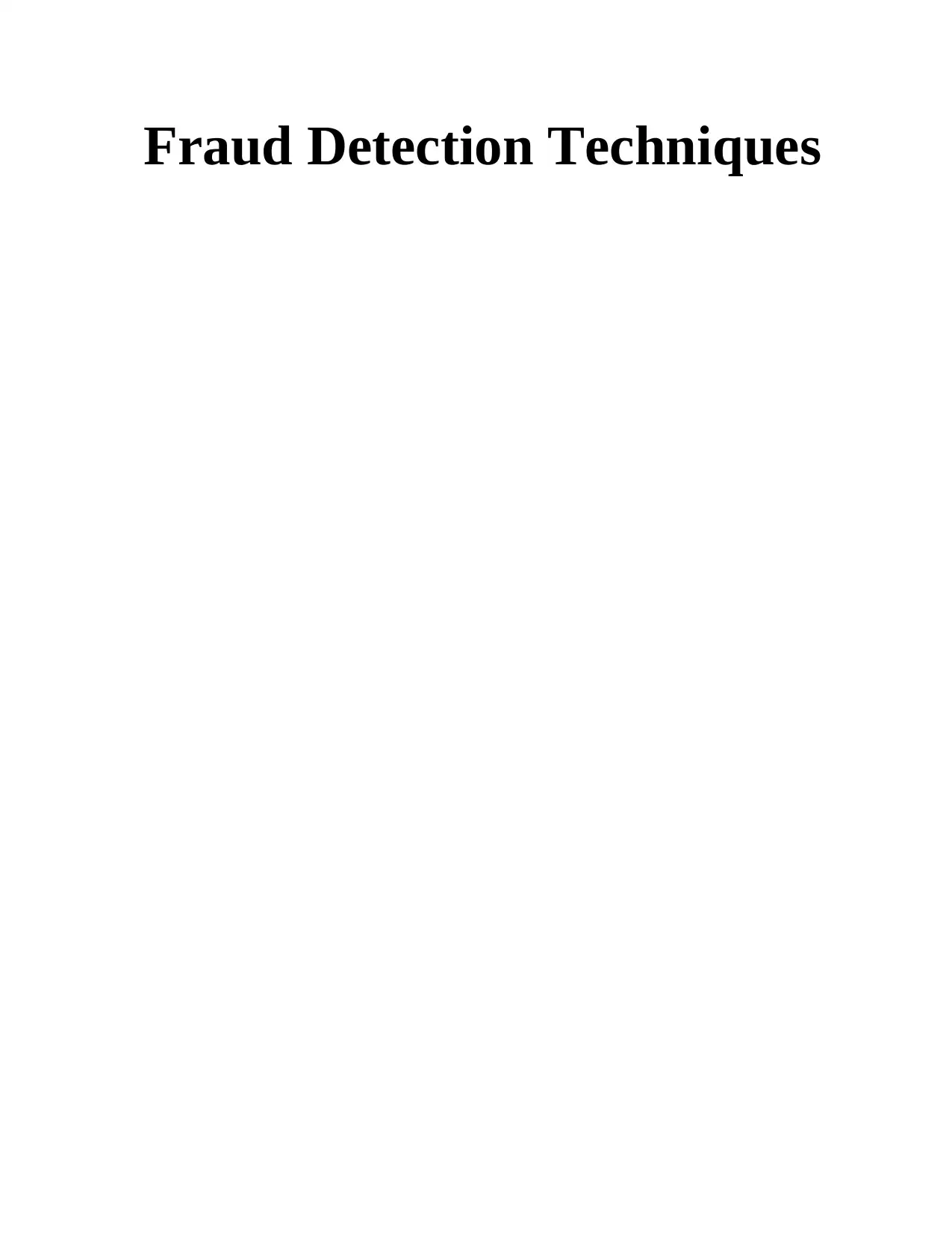
Fraud Detection Techniques
Paraphrase This Document
Need a fresh take? Get an instant paraphrase of this document with our AI Paraphraser
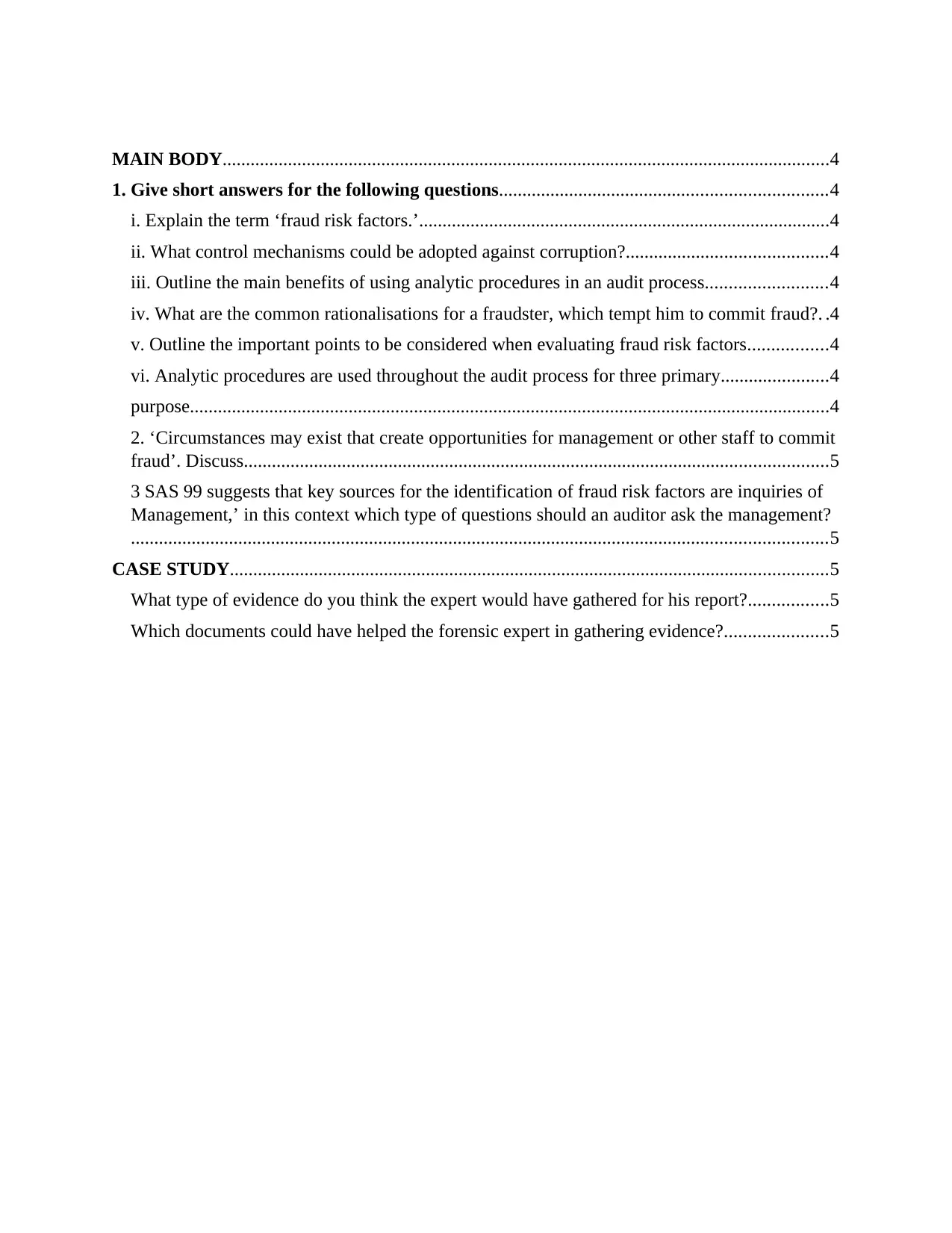
MAIN BODY..................................................................................................................................4
1. Give short answers for the following questions......................................................................4
i. Explain the term ‘fraud risk factors.’........................................................................................4
ii. What control mechanisms could be adopted against corruption?...........................................4
iii. Outline the main benefits of using analytic procedures in an audit process..........................4
iv. What are the common rationalisations for a fraudster, which tempt him to commit fraud?. .4
v. Outline the important points to be considered when evaluating fraud risk factors.................4
vi. Analytic procedures are used throughout the audit process for three primary.......................4
purpose.........................................................................................................................................4
2. ‘Circumstances may exist that create opportunities for management or other staff to commit
fraud’. Discuss.............................................................................................................................5
3 SAS 99 suggests that key sources for the identification of fraud risk factors are inquiries of
Management,’ in this context which type of questions should an auditor ask the management?
.....................................................................................................................................................5
CASE STUDY................................................................................................................................5
What type of evidence do you think the expert would have gathered for his report?.................5
Which documents could have helped the forensic expert in gathering evidence?......................5
1. Give short answers for the following questions......................................................................4
i. Explain the term ‘fraud risk factors.’........................................................................................4
ii. What control mechanisms could be adopted against corruption?...........................................4
iii. Outline the main benefits of using analytic procedures in an audit process..........................4
iv. What are the common rationalisations for a fraudster, which tempt him to commit fraud?. .4
v. Outline the important points to be considered when evaluating fraud risk factors.................4
vi. Analytic procedures are used throughout the audit process for three primary.......................4
purpose.........................................................................................................................................4
2. ‘Circumstances may exist that create opportunities for management or other staff to commit
fraud’. Discuss.............................................................................................................................5
3 SAS 99 suggests that key sources for the identification of fraud risk factors are inquiries of
Management,’ in this context which type of questions should an auditor ask the management?
.....................................................................................................................................................5
CASE STUDY................................................................................................................................5
What type of evidence do you think the expert would have gathered for his report?.................5
Which documents could have helped the forensic expert in gathering evidence?......................5
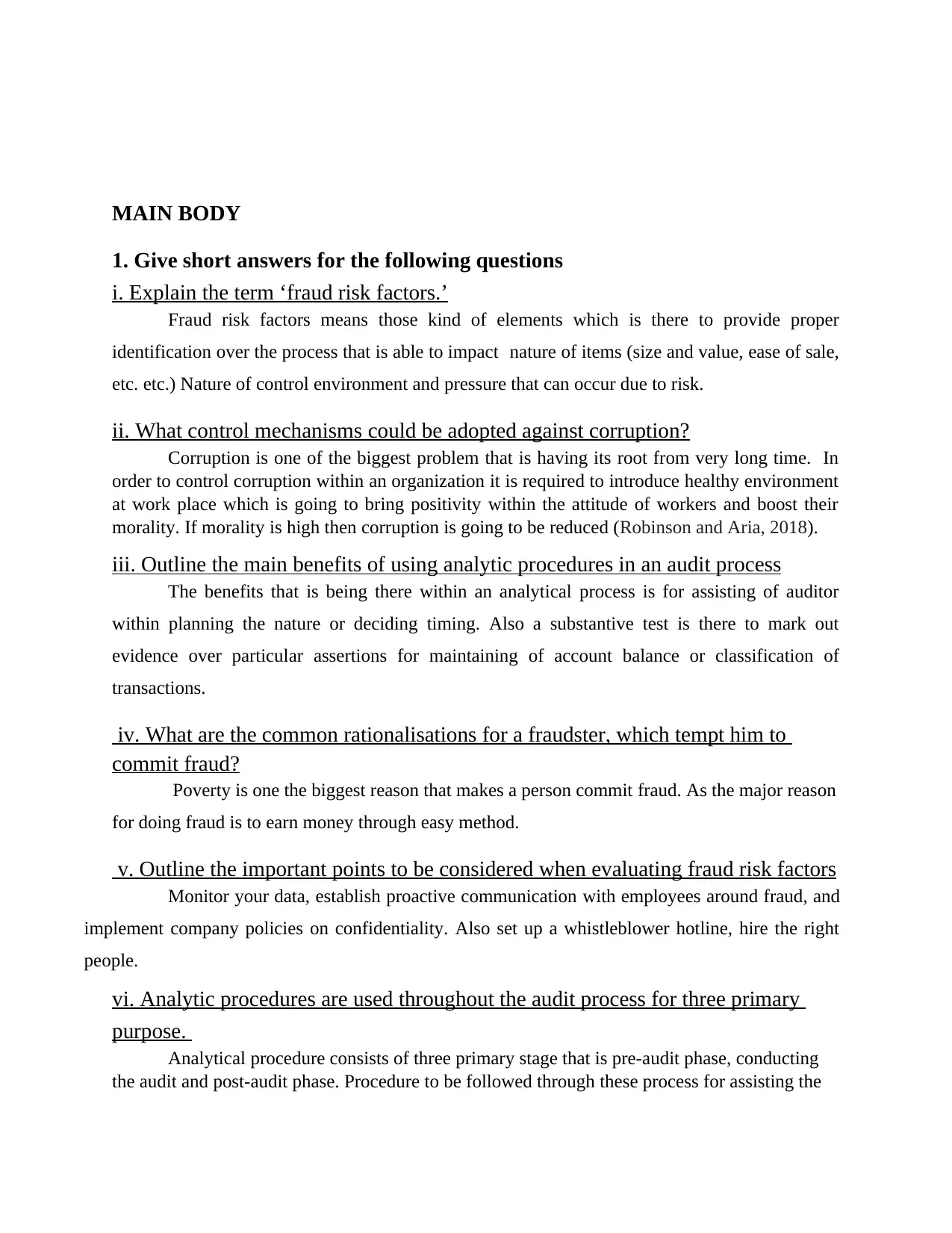
MAIN BODY
1. Give short answers for the following questions
i. Explain the term ‘fraud risk factors.’
Fraud risk factors means those kind of elements which is there to provide proper
identification over the process that is able to impact nature of items (size and value, ease of sale,
etc. etc.) Nature of control environment and pressure that can occur due to risk.
ii. What control mechanisms could be adopted against corruption?
Corruption is one of the biggest problem that is having its root from very long time. In
order to control corruption within an organization it is required to introduce healthy environment
at work place which is going to bring positivity within the attitude of workers and boost their
morality. If morality is high then corruption is going to be reduced (Robinson and Aria, 2018).
iii. Outline the main benefits of using analytic procedures in an audit process
The benefits that is being there within an analytical process is for assisting of auditor
within planning the nature or deciding timing. Also a substantive test is there to mark out
evidence over particular assertions for maintaining of account balance or classification of
transactions.
iv. What are the common rationalisations for a fraudster, which tempt him to
commit fraud?
Poverty is one the biggest reason that makes a person commit fraud. As the major reason
for doing fraud is to earn money through easy method.
v. Outline the important points to be considered when evaluating fraud risk factors
Monitor your data, establish proactive communication with employees around fraud, and
implement company policies on confidentiality. Also set up a whistleblower hotline, hire the right
people.
vi. Analytic procedures are used throughout the audit process for three primary
purpose.
Analytical procedure consists of three primary stage that is pre-audit phase, conducting
the audit and post-audit phase. Procedure to be followed through these process for assisting the
1. Give short answers for the following questions
i. Explain the term ‘fraud risk factors.’
Fraud risk factors means those kind of elements which is there to provide proper
identification over the process that is able to impact nature of items (size and value, ease of sale,
etc. etc.) Nature of control environment and pressure that can occur due to risk.
ii. What control mechanisms could be adopted against corruption?
Corruption is one of the biggest problem that is having its root from very long time. In
order to control corruption within an organization it is required to introduce healthy environment
at work place which is going to bring positivity within the attitude of workers and boost their
morality. If morality is high then corruption is going to be reduced (Robinson and Aria, 2018).
iii. Outline the main benefits of using analytic procedures in an audit process
The benefits that is being there within an analytical process is for assisting of auditor
within planning the nature or deciding timing. Also a substantive test is there to mark out
evidence over particular assertions for maintaining of account balance or classification of
transactions.
iv. What are the common rationalisations for a fraudster, which tempt him to
commit fraud?
Poverty is one the biggest reason that makes a person commit fraud. As the major reason
for doing fraud is to earn money through easy method.
v. Outline the important points to be considered when evaluating fraud risk factors
Monitor your data, establish proactive communication with employees around fraud, and
implement company policies on confidentiality. Also set up a whistleblower hotline, hire the right
people.
vi. Analytic procedures are used throughout the audit process for three primary
purpose.
Analytical procedure consists of three primary stage that is pre-audit phase, conducting
the audit and post-audit phase. Procedure to be followed through these process for assisting the
⊘ This is a preview!⊘
Do you want full access?
Subscribe today to unlock all pages.

Trusted by 1+ million students worldwide
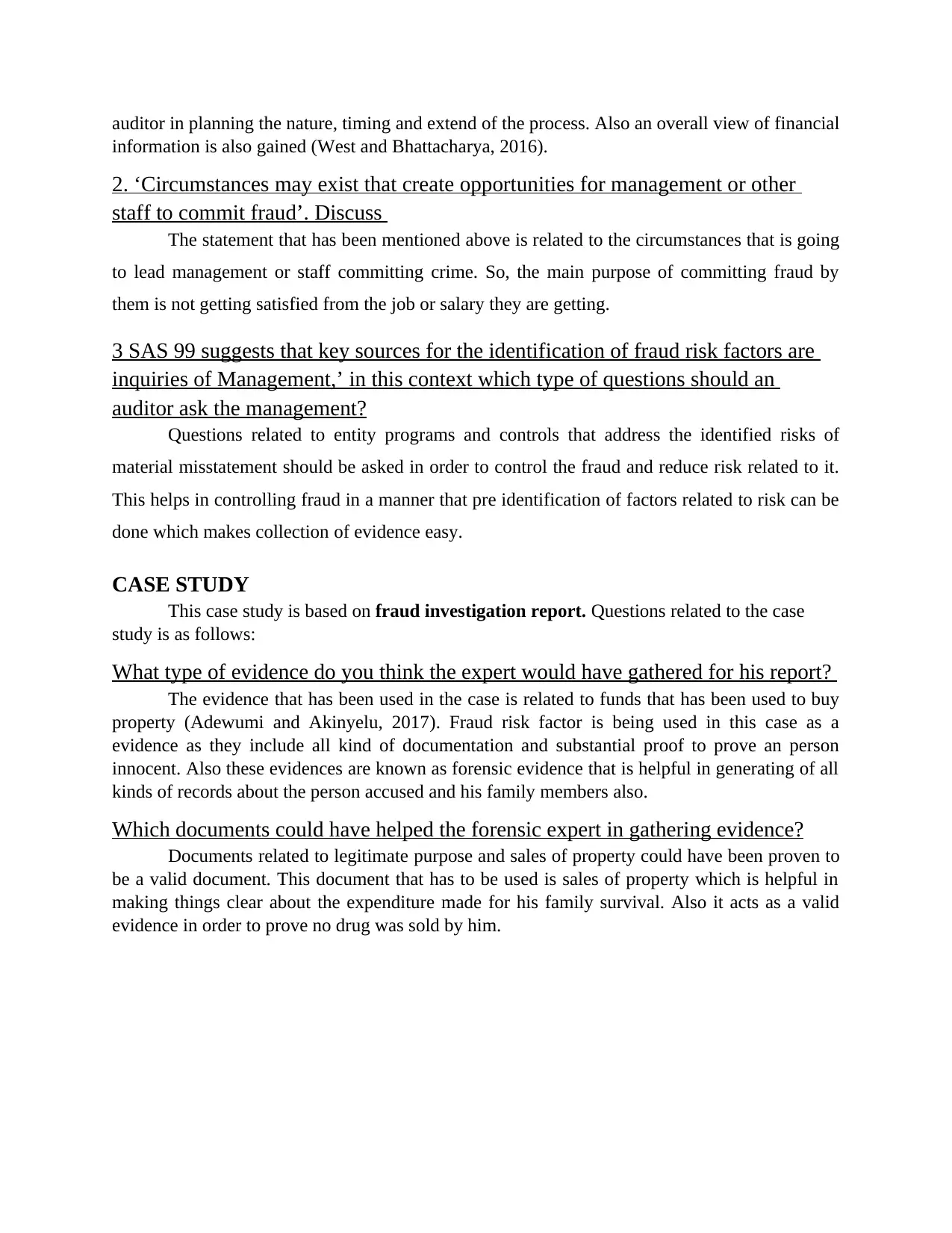
auditor in planning the nature, timing and extend of the process. Also an overall view of financial
information is also gained (West and Bhattacharya, 2016).
2. ‘Circumstances may exist that create opportunities for management or other
staff to commit fraud’. Discuss
The statement that has been mentioned above is related to the circumstances that is going
to lead management or staff committing crime. So, the main purpose of committing fraud by
them is not getting satisfied from the job or salary they are getting.
3 SAS 99 suggests that key sources for the identification of fraud risk factors are
inquiries of Management,’ in this context which type of questions should an
auditor ask the management?
Questions related to entity programs and controls that address the identified risks of
material misstatement should be asked in order to control the fraud and reduce risk related to it.
This helps in controlling fraud in a manner that pre identification of factors related to risk can be
done which makes collection of evidence easy.
CASE STUDY
This case study is based on fraud investigation report. Questions related to the case
study is as follows:
What type of evidence do you think the expert would have gathered for his report?
The evidence that has been used in the case is related to funds that has been used to buy
property (Adewumi and Akinyelu, 2017). Fraud risk factor is being used in this case as a
evidence as they include all kind of documentation and substantial proof to prove an person
innocent. Also these evidences are known as forensic evidence that is helpful in generating of all
kinds of records about the person accused and his family members also.
Which documents could have helped the forensic expert in gathering evidence?
Documents related to legitimate purpose and sales of property could have been proven to
be a valid document. This document that has to be used is sales of property which is helpful in
making things clear about the expenditure made for his family survival. Also it acts as a valid
evidence in order to prove no drug was sold by him.
information is also gained (West and Bhattacharya, 2016).
2. ‘Circumstances may exist that create opportunities for management or other
staff to commit fraud’. Discuss
The statement that has been mentioned above is related to the circumstances that is going
to lead management or staff committing crime. So, the main purpose of committing fraud by
them is not getting satisfied from the job or salary they are getting.
3 SAS 99 suggests that key sources for the identification of fraud risk factors are
inquiries of Management,’ in this context which type of questions should an
auditor ask the management?
Questions related to entity programs and controls that address the identified risks of
material misstatement should be asked in order to control the fraud and reduce risk related to it.
This helps in controlling fraud in a manner that pre identification of factors related to risk can be
done which makes collection of evidence easy.
CASE STUDY
This case study is based on fraud investigation report. Questions related to the case
study is as follows:
What type of evidence do you think the expert would have gathered for his report?
The evidence that has been used in the case is related to funds that has been used to buy
property (Adewumi and Akinyelu, 2017). Fraud risk factor is being used in this case as a
evidence as they include all kind of documentation and substantial proof to prove an person
innocent. Also these evidences are known as forensic evidence that is helpful in generating of all
kinds of records about the person accused and his family members also.
Which documents could have helped the forensic expert in gathering evidence?
Documents related to legitimate purpose and sales of property could have been proven to
be a valid document. This document that has to be used is sales of property which is helpful in
making things clear about the expenditure made for his family survival. Also it acts as a valid
evidence in order to prove no drug was sold by him.
Paraphrase This Document
Need a fresh take? Get an instant paraphrase of this document with our AI Paraphraser
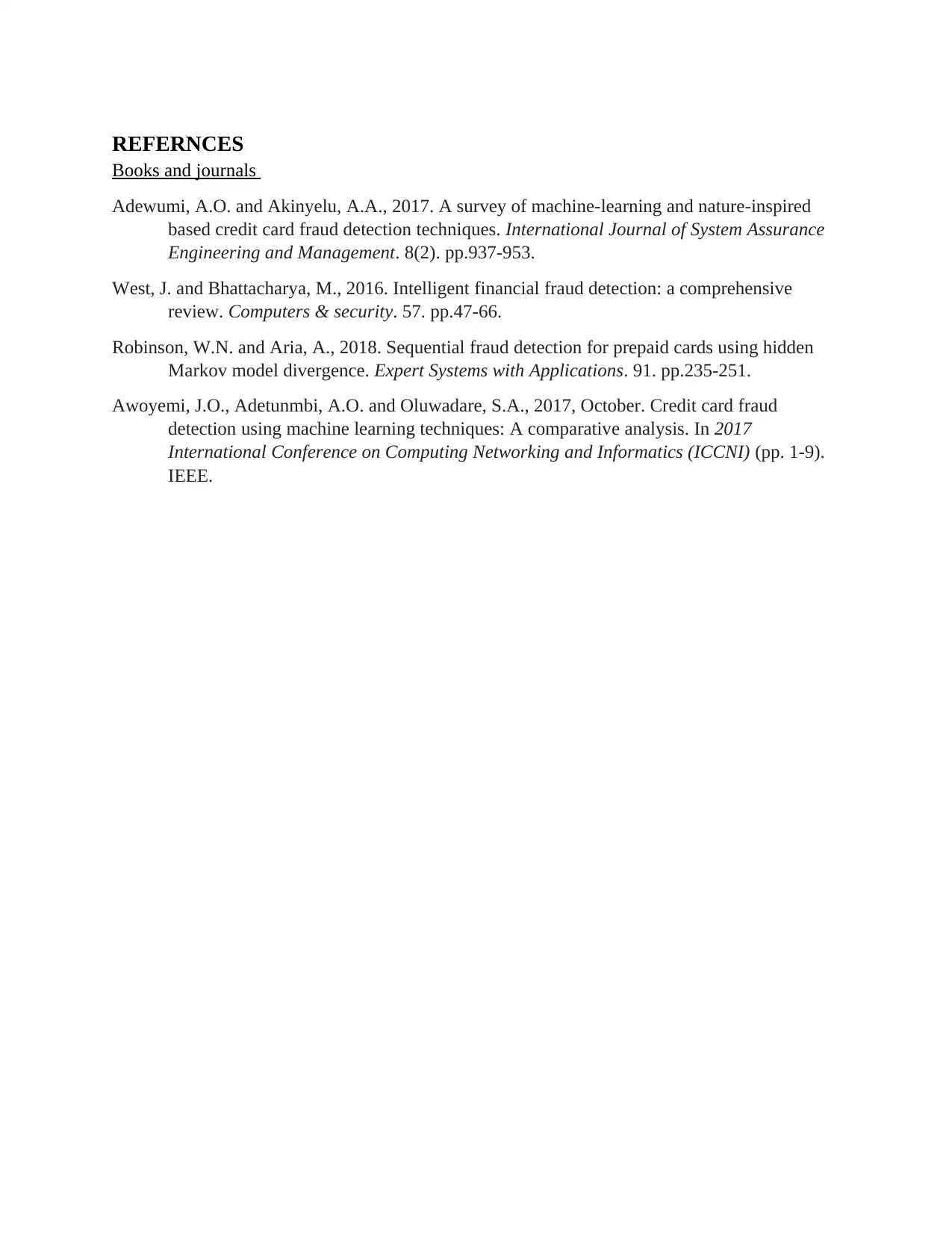
REFERNCES
Books and journals
Adewumi, A.O. and Akinyelu, A.A., 2017. A survey of machine-learning and nature-inspired
based credit card fraud detection techniques. International Journal of System Assurance
Engineering and Management. 8(2). pp.937-953.
West, J. and Bhattacharya, M., 2016. Intelligent financial fraud detection: a comprehensive
review. Computers & security. 57. pp.47-66.
Robinson, W.N. and Aria, A., 2018. Sequential fraud detection for prepaid cards using hidden
Markov model divergence. Expert Systems with Applications. 91. pp.235-251.
Awoyemi, J.O., Adetunmbi, A.O. and Oluwadare, S.A., 2017, October. Credit card fraud
detection using machine learning techniques: A comparative analysis. In 2017
International Conference on Computing Networking and Informatics (ICCNI) (pp. 1-9).
IEEE.
Books and journals
Adewumi, A.O. and Akinyelu, A.A., 2017. A survey of machine-learning and nature-inspired
based credit card fraud detection techniques. International Journal of System Assurance
Engineering and Management. 8(2). pp.937-953.
West, J. and Bhattacharya, M., 2016. Intelligent financial fraud detection: a comprehensive
review. Computers & security. 57. pp.47-66.
Robinson, W.N. and Aria, A., 2018. Sequential fraud detection for prepaid cards using hidden
Markov model divergence. Expert Systems with Applications. 91. pp.235-251.
Awoyemi, J.O., Adetunmbi, A.O. and Oluwadare, S.A., 2017, October. Credit card fraud
detection using machine learning techniques: A comparative analysis. In 2017
International Conference on Computing Networking and Informatics (ICCNI) (pp. 1-9).
IEEE.
1 out of 5
Related Documents
Your All-in-One AI-Powered Toolkit for Academic Success.
+13062052269
info@desklib.com
Available 24*7 on WhatsApp / Email
![[object Object]](/_next/static/media/star-bottom.7253800d.svg)
Unlock your academic potential
Copyright © 2020–2025 A2Z Services. All Rights Reserved. Developed and managed by ZUCOL.





